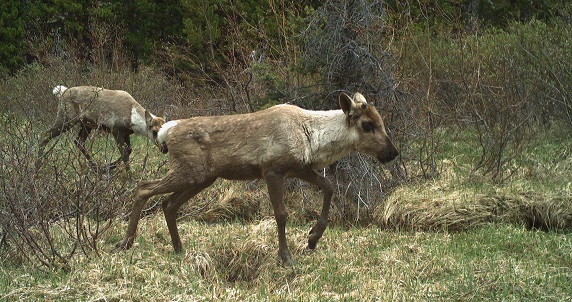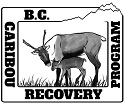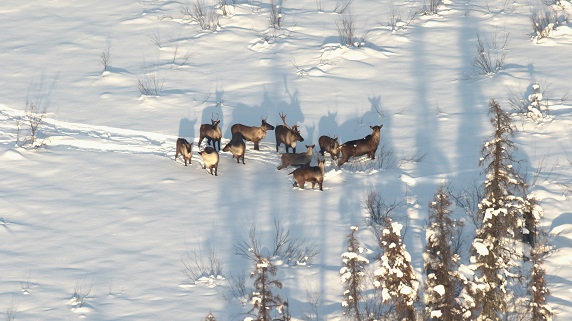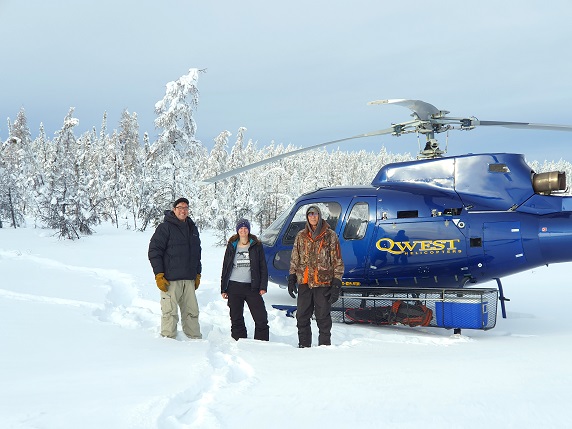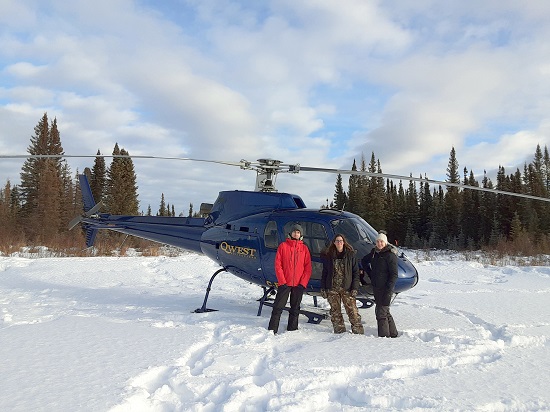Resources
Caribou Recovery Program
Edition: Volume 1, Spring 2024
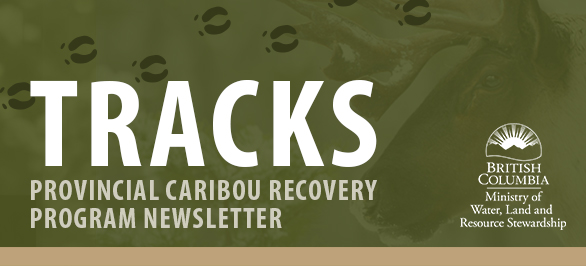
Volume 1, Spring 2024 |

Designatable Unit (DU) 9 - the Southern Group of Southern Mountain CaribouThe Southern Group of Southern Mountain Caribou historically ranged from northern Idaho and eastern Washington in the United States to central British Columbia. Today, they occur approximately 150 km north of the BC-USA border to northeast of Prince George. Nine of the 17 caribou herds in the Southern Group are extirpated (locally extinct) or have less than 10 caribou remaining in them. Fortunately, some of the Southern Group herds have far more caribou. On Oct. 3, 2023, the Caribou Recovery Program started an engagement process for the Southern Mountain Caribou Habitat Initiative, with the objective of defining protection and disturbance thresholds for core and matrix caribou habitat. The initiative will focus on eight herds:
First Nations, the B.C. government, and the Canadian government have been collaborating for over two years on habitat mapping and developing options that will allow caribou to remain on the landscape in the Groundhog, Columbia North, and Central Selkirks herds. By bringing together existing planning efforts and new partnerships, this initiative will provide greater certainty related to caribou habitat and affected parties, leading to a more positive outcome for caribou populations.
|


Intergovernmental Partnership Agreement for the Conservation of the Central Group of the Southern Mountain Caribou (the “Caribou Partnership Agreement”)
Commitment to Action on Racism (Schedule 5)
Important recommendations were developed after a comprehensive review of the 2019 engagement processes related to the Caribou Partnership Agreement - between Canada, B.C., the Saulteau First Nation and the West Moberly First Nation. These signatories are now planning a joint briefing of federal and provincial leadership, Chiefs, and Councils.
A caring, thoughtful, and collaborative approach is important to avoid inciting polarization or anti-Indigenous racism in all engagement processes led by the provincial government in future. Our intention is to share key learnings of the review so we can continue working together to address systemic racism.
Reducing Disturbances Across Critical Habitat (Clause 33)
Collaborative planning for habitat restoration by the Caribou Partnership Agreement signatories was initiated in late 2022 and is ongoing. The next phase involves refining priority areas within caribou ranges and specific linear features (e.g., roads, seismic lines, ) for restoration, with the goal of producing a multi-year implementation plan.
A proposed implementation plan will be shared for feedback during open houses that will begin in the fall of 2024. In general, before any caribou habitat restoration activities begin, we send information packages to affected parties. These packages provide a way for affected parties to reach out to the team with questions or concerns about specific restoration projects.
We are constantly working to improve how we implement caribou habitat restoration projects, including identifying projects in high use, high quality habitat that could be completed relatively easily, improving the efficiency of the permitting process, and increasing the resources we need to conduct restoration.
Managing Motorized Recreation (Winter Motorized Recreation Compliance and Enforcement) (Clause 37)
The Conservation Officer Service of the Ministry of Environment and Climate Change Strategy conducted patrols in the fall of 2023 using side-by-side vehicles, and this past winter by helicopter.
Fewer people than usual were engaging in motorized recreational activities (e.g., snowmobiling), due to the lack of snow and cold temperatures. There have been no notable infractions recorded to date.
Members of the Caribou Recovery Program team were present at the Dawson Creek Sportsman Show in April 2024 to share educational resources with attendees.
Land Use Objectives Related to Caribou Recovery (Schedule 2)
Work is underway regarding proposed Land Use Objectives related to caribou recovery. When an engagement process takes place, the B.C. government will work closely with affected parties and First Nations to understand potential socio-economic impacts. It would bring in a third-party contractor to facilitate this collaborative engagement process.


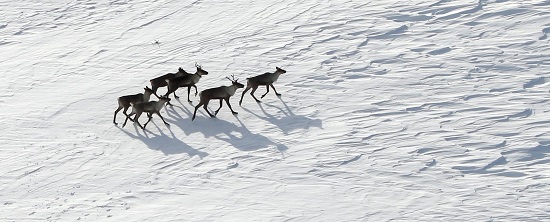
B.C. Boreal Caribou DNA Surveys
We are pleased to share the latest developments from the non-invasive DNA surveys conducted by the Ministry of Water, Land and Resource Stewardship’s Caribou Recovery Program (CRP) in collaboration with several First Nations communities, including:
- Fort Nelson
- Prophet River
- Doig River
- Blueberry River
- Acho Dene Koe First Nation
From 2021 to 2024, these surveys have been instrumental in the collection of valuable caribou DNA data, using a non-invasive technique. Caribou fecal pellets are analysed to identify individual caribou. An individual is considered “recaptured” when its genetic profile appears across two or more sampling sessions.
The surveys take place over three sessions (December, January, and February). Aircraft carrying observers are flown along transects spaced three or six kilometres apart, depending on the size of the survey area. The survey areas are based on caribou population boundaries and areas where the presence of caribou has been confirmed by partner First Nations and their knowledge holders.
The primary objective of the DNA surveys is to obtain a population estimate, which will complement information we obtain from other types of surveys (such as of the number of calves that will become juveniles). Fieldwork includes coordinating DNA sample collections with caribou capture crews and providing these crews with the locations of uncollared groups. Additionally, genetic analyses help describe the connections between boreal and mountain caribou, and provide insight into the proportion of bulls participating in reproduction.
Fecal samples have been collected in four out of five boreal ranges and the Hay River “area of interest” (AOI). The collected samples are now being processed at specialized wildlife genetics and genomics labs.
Preliminary results from the Westside Fort Nelson caribou range indicate a population of 203 animals, with further analyses pending or planned for the next year. The table below indicates the number of sites where samples were collected, and the crew size needed to sample each population. Further, efforts are underway to develop genomic tools to identify chronic wasting disease (CWD) transmission risk from these fecal samples.
This collaborative project exemplifies the importance of working with First Nations to address key data gaps related to boreal caribou. This work, which will be featured in an upcoming documentary, has provided samples for the development of new technologies in genomics analyses and for the rapid identification of species from fecal samples.
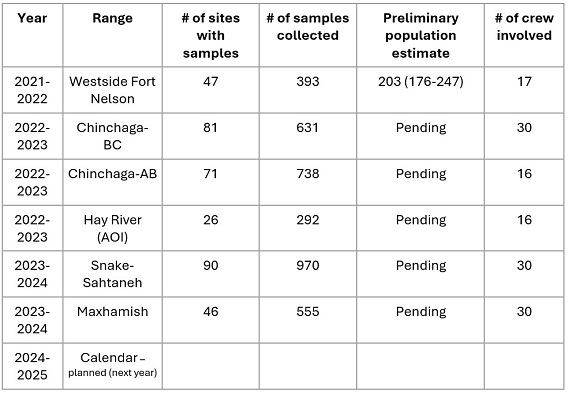
Additional photos from the Boreal Caribou DNA Surveys:

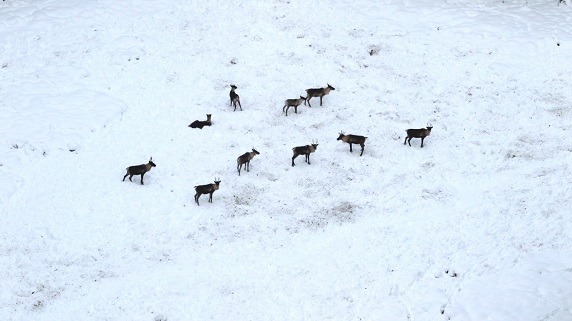


Boreal Caribou Protection and Recovery
The Boreal Caribou Protection and Recovery Plan (BCPRP) was co-developed by Fort Nelson First Nations and the government of B.C. It covers the four northernmost boreal caribou herds in British Columbia:
- Maxhamish
- Calendar
- Snake-Sahtaneh
- Westside Fort Nelson
The recovery plan was endorsed by the Environment and Land Use Committee (ELUC) of the provincial government cabinet in 2023 and is now advancing onto its next stages.
The BCPRP team is diligently aligning the plan’s commitments with ongoing land-use planning initiatives. The team is prioritizing interim habitat protection in important caribou habitat, identified as Type 1 and Type 2 management measures in the BCPRP. These measures aim for interim caribou habitat protection within Management Types 1 and 2 for the forestry sector and Management Type 1 for the oil and gas sector. These interim protections will be in place as the Liard Water and Land Stewardship Forum (LWLSF) process progresses.
Type 3 and Type 4 management measures, which would allow for conditional development, are being deferred to the LWLSF process. Establishing habitat protection measures remains the top priority, but the BCPRP team is also advancing the following commitments simultaneously:
- increased monitoring of boreal caribou populations
- planning of priority habitat restoration work
- predator monitoring in boreal caribou ranges
The Province is dedicated to ensuring the long-term health and sustainability of boreal caribou populations, and these efforts mark significant steps towards that goal.
Read more on the plan: https://engage.gov.bc.ca/caribou/boreal-caribou/


2023-2024 Caribou Population Survey Update
Aerial surveys are critical for assessing caribou populations in British Columbia and are typically conducted in March when daylight hours are sufficient and snow conditions allow for tracking. These surveys aim to estimate caribou population size and the number of calves that will become juveniles (>1 year old) — also known as “calf recruitment”. These surveys enable comparisons over time to evaluate the status of these populations and the effectiveness of caribou recovery efforts. Below is a summary of the survey work conducted by the Caribou Recovery Program over the past year, with the support of our partners.
Caribou surveys
- In 2023-24, calf recruitment surveys were conducted in the following caribou ranges: North Cariboo Mountains, Quintette, Telkwa, Central Selkirks, Tweedsmuir-Entiako, Westside Fort Nelson, Chinchaga, Calendar, Maxhamish, and Snake-Sahtaneh.
- These surveys involve directly tracking GPS-collared caribou to obtain a minimum count and classifying each animal found as either an adult or a 10-month-old calf.
- When a good sample of caribou are observed across a range, the percentage of calves provides a good indication of whether the population is growing (> 15% calves in a population is considered the minimum target for growth), stable, or declining.
- To estimate caribou population size, a method called “mark-resight” was used to survey caribou in the Graham, Kennedy Siding/Burnt Pine, Parsnip, Hart South, Tweedsmuir-Entiako, Spatsizi, and Itcha-Ilgachuz ranges.
- Mark-resight: A mark-resight survey follows a total count survey methodology where surveyors note how many observed caribou have GPS-collars versus the total number of known collared caribou within the range. The proportion of collared animals sighted and not sighted provides an estimate of “sightability”, which is used to calculate a population estimate.
- DNA surveys to collect fecal matter samples were conducted in the Snake-Sahtaneh and Maxhamish ranges (see details above).
- Cameras were used to monitor caribou in the Kennedy Siding range where physical metrics (antler configuration and size) were recorded to identify individuals, body condition, calf recruitment and population size. This technique is only used in the Kennedy Siding range, because (in most years) the entire population moves down to its low-elevation winter range.
Prey and predator surveys
- The decline of caribou populations is closely intertwined with increased numbers of predators and the predators’ primary prey (i.e., moose, deer, and elk), so it is important to monitor these species as well.
- Two moose population surveys (“stratified random block surveys”) were flown in the Klinse-Za and Tweedsmuir-Entiako caribou ranges in January 2024 to assess changes in moose abundance and composition in response to predator reduction measures.
- A “minimum count snow track survey” of wolves was also completed in February 2024 in the Chase caribou range to estimate wolf population density, number of packs, and distribution.
Survey challenges
- Snow depth affects caribou movements, since deeper snow at lower elevations typically pushes caribou to higher elevations in subalpine and alpine habitats, where they can be more easily counted during surveys.
- The lower-than-average snowpack during the winter of 2023-2024 led to challenging or poor survey conditions, which resulted in several surveys being postponed or forced a shift in survey methodology.
- Specifically, the mark-resight surveys planned for the Pink Mountain, Columbia North, and Central-Selkirks ranges were postponed, and the one planned for the North Cariboo Mountains range was changed to a recruitment survey. Mark-resight surveys in these ranges will be prioritized for 2024-2025.
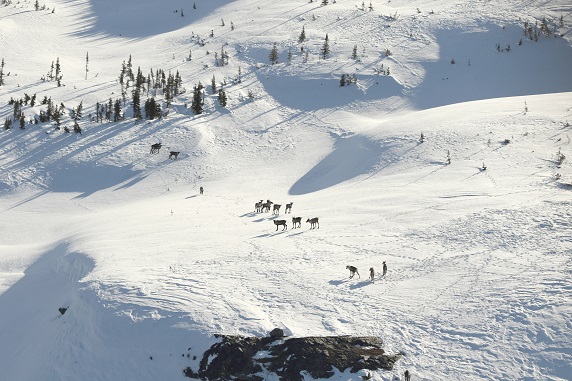


Predator Reduction
Our winter predator reduction efforts for the 2023-2024 season concluded on March 31, 2024. They aimed to support the recovery of 15 caribou herds. However, abnormally mild winter conditions and low snow levels led to predator reduction activities being entirely canceled in the Chinchaga caribou range and halted in late winter in the Graham caribou range, due to inadequate conditions for tracking and removing wolves. Despite these challenges, predator reduction efforts in other treatment areas proceeded. They appeared to be largely successful and are expected to contribute to future caribou population growth in those areas. The Caribou Recovery Program is currently summarizing the predator reduction data and will provide an update once that work is complete.
Caribou Recovery Program staff have been diligently monitoring caribou, predators, and other prey species to assess the effects of predator reduction and will share more information in future updates. See the recently published article “Effectiveness of population-based recovery actions for threatened southern mountain caribou” for a comprehensive assessment of this management activity as well as others.


Growing the Restoration Economy Workshop
In January 2024, 70 people from various sectors throughout British Columbia gathered for a workshop to help draft a roadmap for caribou habitat restoration. The workshop brought together restoration practitioners (i.e., people who undertake habitat restoration on the ground) and strategic decision-makers to reflect on their experiences with land restoration, focusing on caribou habitat and forest landscape restoration. The goal was to identify opportunities to foster the restoration economy in British Columbia.
Discussions centered around four key pathways:
- Building partner capacity and supporting training opportunities
- Reducing regulatory and policy barriers (e.g., permitting requirements and timelines)
- Achieving co-benefits (e.g., benefits to other wildlife, ecosystems, communities) and resiliency (e.g., for employment, industry, communities, First Nations) for restoration efforts
- Monitoring outcomes of caribou habitat restoration efforts
For this workshop, “restoration economy” was defined as a collection of economic activities that assist with the recovery of ecosystems that have been degraded, damaged, or destroyed. A restoration economy supports opportunities for existing companies and organizations to do that work while also creating new niches and opportunities for companies and organizations that may not exist yet.
Throughout the workshop, several themes emerged:
- Identifying a need for consistent standards to drive restoration towards a common goal. Without clear and consistent standards across ministries, participants noted that the outcomes of restoration are left to proponents and may not consistently achieve provincial goals (such as caribou conservation).
- Understanding that restoration efforts should include First Nations at the outset of projects. This discussion noted the critical role that First Nations play in growing a restoration economy and managing landscapes to achieve restoration goals.
- Motivation to see restoration activities transition from individual, fragmented projects towards a system that focuses on directing these efforts towards large landscapes. The potential of large, landscape-scale restoration will require focused efforts and a strong vision.
- Recognition that focused effort is required to train workers through regional colleges and prepare the workforce for the emerging opportunities of a restoration economy.
- Acknowledgement of the importance of completing a regulatory review to remove barriers and increase the efficiency and predictability of restoration project approvals. Participants noted that unpredictability related to permitting and multiple layers of approvals are slowing restoration activities on the ground.
- Awareness that long-term funding stability, year-round employment opportunities, and understanding and growing the supply chain will be critical for providing the necessary foundation to grow the restoration economy and provide stable employment.
- A strong desire to have more socio-economic perspectives at the table. Participants recognized that many ideas that emerged at the workshop focused on the ecological aspects of growing the restoration economy and that additional perspectives on socio-economic aspects of this work are required.
Building on these themes, participants identified 20 priority actions and an overarching need for a centralized “hub” to guide habitat restoration in B.C.
The concept of a hub emerged as a proposed action within three of the four pathways:
- Monitoring outcomes of habitat restoration projects and its impact on economy
- Achieving co-benefits (e.g., benefits to other wildlife, ecosystems, communities) and resiliency for employment, industry, communities, and First Nations
- Reducing regulatory and policy barriers to increase the efficiency of restoration project approvals (e.g., permitting requirements and timelines)
A central hub would support consistent monitoring standards, house data, drive more consistent and efficient regulations, focus restoration efforts to achieve co-benefits, and, in general, champion restoration projects in this province.
The workshop showcased significant enthusiasm for caribou and other terrestrial habitat restoration in B.C., presenting a unique opportunity to transition the restoration economy from concept to reality. While challenges still lie ahead, focused efforts are crucial for advancing this goal.


Learn More
- Provincial Caribou Recovery Program
- Canada British Columbia Conservation Agreement for Southern Mountain Caribou in British Columbia
- Partnership Agreement for the Conservation of the Southern Mountain Caribou – Central Group
- Boreal Protection Recovery plan https://engage.gov.bc.ca/caribou/boreal-caribou/
- Caribou Herd Ranges prioritized for Predator Reduction Program in BC
